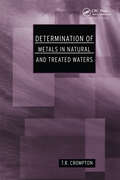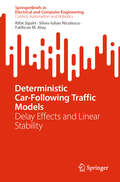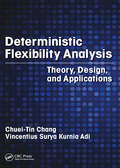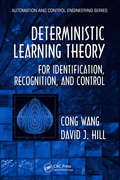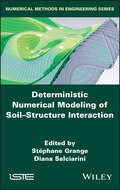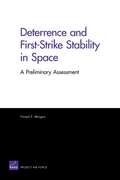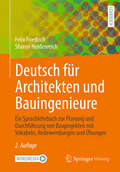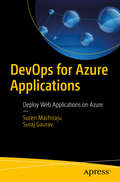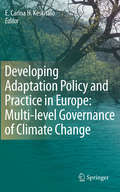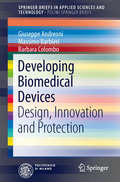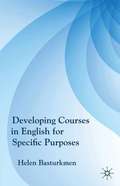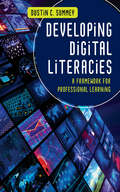- Table View
- List View
Determination of Metals in Natural and Treated Water (Determination Techniques - The Complete Set)
by T R CromptonDetermination of Metals in Natural and Treated Waters draws together all the available literature and presents in a systematic fashion the latest analytical techniques for detecting metals in non-saline and saline natural and treated water. Broad outlines of different methods and their applicability in certain situations are given allowing the chem
Determination of Target Xenobiotics and Unknown Compound Residues in Food, Environmental, and Biological Samples (Chromatographic Science Series)
by Tomasz Tuzimski Joseph ShermaXenobiotics are chemical compounds foreign to a given biological system. In animals and humans, xenobiotics include drugs, drug metabolites, and environmental pollutants. In the environment, xenobiotics include synthetic pesticides, herbicides, and industrial pollutants. Many techniques are used in xenobiotics residue analysis; the method selected depends on the complexity of the sample, the nature of the matrix/analytes, and the analytical techniques available. This reference will help the analyst develop effective and validated analytical strategies for the analysis of hundreds of different xenobiotics on hundreds of different sample types, quickly, accurately and at acceptable cost.
Deterministic Car-Following Traffic Models: Delay Effects and Linear Stability (SpringerBriefs in Electrical and Computer Engineering)
by Silviu-Iulian Niculescu Rifat Sipahi Fatihcan M. AtayThis book is a study of the effects of delays, stemming from a range of sources, on the behaviour of traffic flow. It provides the reader with theoretical approaches and computational tools, including existing tools from the field of control systems, for analysing the stability and slinky features of dynamical systems affected by time delays. Through examples and case-studies it shows how to implement these tools on a variety of traffic-flow models. The models considered are microscopic flow models (dealing with the behaviour of individual vehicles rather than the study of group effects) formulated as continuous-time deterministic delay-differential equations. Physiological lag (human reaction), mechanical time-lag and the delay time of vehicular motion are only a few examples of the multitude of delays that are applied to a traffic model. Such delays may also be discrete (constant), distributed or time-varying; the text concentrates on the constant and distributed delays associated with the representation of linear stability and slinky features to allow a compact and analytically tractable demonstration of the intricacy of delay effects. Readers with an academic research background in applied maths, vehicle dynamics and traffic modelling and graduate students working in those fields will find this brief to be an interesting source of results and openings for further work. It is also useful for engineers working on traffic-management systems and the guidance and control of autonomous vehicles.
Deterministic Flexibility Analysis: Theory, Design, and Applications
by Chuei-Tin Chang Vincentius Surya Kurnia AdiTraditionally, design and control decisions are made in sequential stages over the life cycle of a chemical plant. In the design phase, the optimal operating conditions and the corresponding material and energy balance data are established mainly on the basis of economic considerations. In the subsequent step, the control systems are configured to maintain the key process conditions at the fixed nominal values. Because it is often desirable to address the operability issues at the earliest possible stage before stipulation of control schemes, the systematic incorporation of flexibility analysis in process synthesis and design has received considerable attention in recent years. This book focuses to a large extent on computation and implementation methods of deterministic performance measures, i.e., the steady-state, volumetric, dynamic and temporal flexibility indices, in various applications. The formal definitions of several available performance indices, their mathematical formulations, and the corresponding algorithms and codes are provided in sufficient detail to facilitate implementation. To show the utility of flexibility analyses, the book presents several practical case studies including membrane modules and heat-exchanger networks, solar-driven membrane distillation desalination systems, and hybrid power generation systems. It also includes MATLAB and GAMS codes.
Deterministic Learning Theory for Identification, Recognition, and Control (Automation and Control Engineering #32)
by Cong Wang David J. HillDeterministic Learning Theory for Identification, Recognition, and Control presents a unified conceptual framework for knowledge acquisition, representation, and knowledge utilization in uncertain dynamic environments. It provides systematic design approaches for identification, recognition, and control of linear uncertain systems. Unlike many books currently available that focus on statistical principles, this book stresses learning through closed-loop neural control, effective representation and recognition of temporal patterns in a deterministic way. A Deterministic View of Learning in Dynamic Environments The authors begin with an introduction to the concepts of deterministic learning theory, followed by a discussion of the persistent excitation property of RBF networks. They describe the elements of deterministic learning, and address dynamical pattern recognition and pattern-based control processes. The results are applicable to areas such as detection and isolation of oscillation faults, ECG/EEG pattern recognition, robot learning and control, and security analysis and control of power systems. A New Model of Information Processing This book elucidates a learning theory which is developed using concepts and tools from the discipline of systems and control. Fundamental knowledge about system dynamics is obtained from dynamical processes, and is then utilized to achieve rapid recognition of dynamical patterns and pattern-based closed-loop control via the so-called internal and dynamical matching of system dynamics. This actually represents a new model of information processing, i.e. a model of dynamical parallel distributed processing (DPDP).
Deterministic Numerical Modeling of Soil Structure Interaction
by Diana Salciarini Stéphane GrangeIn order to describe soil–structure interaction in various situations (nonlinear, static, dynamic, hydro-mechanical couplings), this book gives an overview of the main modeling methods developed in geotechnical engineering. The chapters are centered around: the finite element method (FEM), the finite difference method (FDM), and the discrete element method (DEM). Deterministic Numerical Modeling of Soil–Structure Interaction allows the reader to explore the classical and well-known FEM and FDM, using interface and contact elements available for coupled hydro-mechanical problems.Furthermore, this book provides insight on the DEM, adapted for interaction laws at the grain level. Within a classical finite element framework, the concept of macro-element is introduced, which generalizes constitutive laws of SSI and is particularly straightforward in dynamic situations. Finally, this book presents the SSI, in the case of a group of structures, such as buildings in a town, using the notion of metamaterials and a geophysics approach.
Deterministic Solvers for the Boltzmann Transport Equation
by Anh-Tuan Pham Sung-Min Hong Christoph JungemannThe book covers all aspects from the expansion of the Boltzmann transport equation with harmonic functions to application to devices, where transport in the bulk and in inversion layers is considered. The important aspects of stabilization and band structure mapping are discussed in detail. This is done not only for the full band structure of the 3D k-space, but also for the warped band structure of the quasi 2D hole gas. Efficient methods for building the Schrödinger equation for arbitrary surface or strain directions, gridding of the 2D k-space and solving it together with the other two equations are presented.
Deterministic, Stochastic, and Deep Learning Methods for Computational Electromagnetics
by Wei CaiThis book provides a well-balanced and comprehensive picture based on clear physics, solid mathematical formulation, and state-of-the-art useful numerical methods in deterministic, stochastic, deep neural network machine learning approaches for computer simulations of electromagnetic and transport processes in biology, microwave and optical wave devices, and nano-electronics. Computational research has become strongly influenced by interactions from many different areas including biology, physics, chemistry, engineering, etc. A multifaceted approach addressing the interconnection among mathematical algorithms and physical foundation and application is much needed to prepare graduate students and researchers in applied mathematics and sciences and engineering for innovative advanced computational research in many applications areas, such as biomolecular solvation in solvents, radar wave scattering, the interaction of lights with plasmonic materials, plasma physics, quantum dots, electronic structure, current flows in nano-electronics, and microchip designs, etc.
Deterrence and First-Strike Stability in Space
by Forrest E. MorganSpace stability appears to be eroding as a growing number of states acquire the ability to degrade or destroy U.S. space assets. The United States needs a coordinated national space deterrence strategy designed to operate on both sides of a potential adversary's cost-benefit decision calculus. Future research will determine the most effective and affordable mix of strategies, policies, and systems for strengthening space deterrence.
Deterrence: Lessons from Six Decades of Rand Deterrence Research
by Austin LongSince its inception six decades ago, the RAND Corporation has been one of the key institutional homes for the study of deterrence. This book examines much of this research for lessons relevant to the current and future strategic environment. It is therefore part intellectual history and part policy recommendation, intended to encourage debate and discussion on how deterrence can best be incorporated into U.S. strategy.
Deterring International Terrorism and Rogue States: US National Security Policy after 9/11 (Contemporary Security Studies)
by James H. LebovicThis new study challenges the widely held view that many current US adversaries cannot be deterred, maintaining that deterrence is not a relic of the Cold War period and that it should shape US policies toward so-called ‘rogue states’ and terror groups. James Lebovic argues that deterrence principles continue to apply, and focuses upon the ‘three pillars’ of the Bush administration’s national security policy: missile defence, which preoccupied the administration until September 11, 2001 pre-emption, which became the US focus with the September 11 attacks and US success in overthrowing the Taliban regime in Afghanistan homeland security, which the administration has portrayed as more a natural response to threat than an aspect of policy that must be reconciled with the other pillars. Deterring International Terrorism and Rogue States asserts that bad offences and defences have been endemic to the current US policy approach, leading US policy makers to pursue policies that require them to do everything without adequate concern for resource trade-offs, overreach, and unintended consequences. This book will be of great interest to students of US foreign policy, national and international security, terrorism and international relations in general.
Detour New Mexico: Historic Destinations & Natural Wonders
by Arthur Pike David PikeNew Mexico’s rich and varied history is easily accessible via detours down obscure backroads and overlooked off-ramps. By taking the road less traveled in any direction, visitors can experience ancient landmarks, cultural heritage sites and striking vistas. Stop at places along the old Route 66, sample the world’s best chiles by the Rio Grande or soak in geothermal water flowing under Truth or Consequences. Ancient dwellings in remote canyons, the town where the first atomic bomb was secretly assembled and the grave of Billy the Kid all lie off the beaten path in the Land of Enchantment. Authors Arthur and David Pike map out these and many more worthwhile points of interest for the curious traveler.
Deus in Machina: Religion, Technology, and the Things in Between
by Jeremy StolowThe essays in this volume explore how two domains of human experience and action—religion and technology—are implicated in each other. Contrary to commonsense understandings of both religion (as an “otherworldly” orientation) and technology (as the name for tools, techniques, and expert knowledges oriented to “this” world), the contributors to this volume challenge the grounds on which this division has been erected in the first place.What sorts of things come to light when one allows religion and technology to mingle freely? In an effort to answer that question, Deus in Machina embarks upon an interdisciplinary voyage across diverse traditions and contexts where religion and technology meet: from the design of clocks in medieval Christian Europe, to the healing power of prayer in premodern Buddhist Japan, to 19th-century Spiritualist devices for communicating with the dead, to Islamic debates about kidney dialysis in contemporary Egypt, to the work of disability activists using documentary film to reimagine Jewish kinship, to the representation of Haitian Vodou on the Internet, among other case studies.Combining rich historical and ethnographic detail with extended theoretical reflection, Deus in Machina outlines new directions for the study of religion and/as technology that will resonate across the human sciences, including religious studies, science and technology studies, communication studies, history, anthropology, and philosophy.
Deuteride Materials
by Jiping Liu Xiaobo LiuThis is the very first book that offers an up-to-date and comprehensive overview on deuteride. It not only includes the concept, existing forms, key characteristics, but also reviews the preparation and characterization technologies and the latest research developments of deuteride. The special properties such as the nuclear properties, isotropic and neutron effect, poisonousness, radioactivity, volume expansion are systematically discussed to build up the sound understanding of the materials. In particular, this work reviews a number of commercial and scientific uses of the materials including nuclear reactors, NMR spectroscopy and medicines. Researchers and industrial professionals in medicine, chemistry, biochemistry, environmental sciences and defense sciences will benefit from this work.
Deutsch für Architekten und Bauingenieure: Ein Sprachlehrbuch zur Planung und Durchführung von Bauprojekten mit Vokabeln, Redewendungen und Übungen
by Sharon Heidenreich Felix FriedrichEin Sprachlehrbuch, das speziell für Architekten, Bauingenieure und verwandte Berufsgruppen aller Nationalitäten konzipiert ist, die ihre deutsche Kommunikationsfähigkeit im beruflichen Kontext verbessern wollen. Das Buch kann sowohl für das Selbststudium als auch kursbegleitend eingesetzt werden. Nachdem in der 1. Hälfte des Buches viele Grundlagen der Bauwirtschaft behandelt werden, orientiert sich die 2. Hälfte an den Leistungsphasen und der Abwicklung von Beispielprojekten. Pro Kapitel werden Fachvokabular, Redewendungen, Kommunikationsformen und auch Grammatik vermittelt. Übungen und Aufgaben mit Lösungen runden das Werk ab.Nach dem Gemeinsamen europäischen Referenzrahmen (GER) für Sprachen entspricht das Lehrwerk einem Niveau von B2/C1.
Deutsch für Architekten und Bauingenieure: Ein Sprachlehrbuch zur Planung und Durchführung von Bauprojekten mit Vokabeln, Redewendungen und Übungen
by Sharon Heidenreich Felix FriedrichEin Sprachlehrbuch, das speziell für Architekten, Bauingenieure und verwandte Berufsgruppen aller Nationalitäten konzipiert ist, die ihre deutsche Kommunikationsfähigkeit im beruflichen Kontext verbessern wollen. Das Buch kann sowohl für das Selbststudium als auch kursbegleitend eingesetzt werden. Nachdem in der 1. Hälfte des Buches viele Grundlagen der Bauwirtschaft behandelt werden, orientiert sich die 2. Hälfte an den Leistungsphasen und der Abwicklung von Beispielprojekten. Pro Kapitel werden Fachvokabular, Redewendungen, Kommunikationsformen und auch Grammatik vermittelt. Übungen und Aufgaben mit Lösungen runden das Werk ab. Neu in der 2. Auflage: Alle Dialoge stehen als Audiodateien zur Verfügung. Durch QR-Codes im Buch können diese abgerufen und direkt angehört werden. Nach dem Gemeinsamen europäischen Referenzrahmen (GER) für Sprachen entspricht das Lehrwerk einem Niveau von B2/C1.
DevOps for Azure Applications: Deploy And Integrate Web Applications On Azure
by Suren Machiraju Suraj GauravDeploy web applications on Azure using DevOps tools. This book gives solutions to real-world Cloud deployment scenarios which will enable you to become adept in DevOps work for Azure.You'll start by seeing an overview of DevOps for Azure deployments where you will also survey the available tools, including Octopus Deploy and TeamCity. Here, you will learn how to use TeamCity as a CI tool and Octopus Deploy as release-management and CD software to get your package deployed on Azure Web Application. Next, the authors demonstrate using the Microsoft Visual Studio Team Services (VSTS) integrated developer platform. Finally, you will go through some real-world scenarios using DevOps tools to deploy web applications on Azure. To do this, you will create resources in Azure and integrate with an open source buildout.After reading this book, you will be ready to use various tools in a DevOps environment to support an Azure deployment.What You Will LearnCarry out a survey of DevOps toolsBuild a DevOps solution using standalone DevOps tools – TeamCity and Octopus DeployUse an integrated DevOps platform – VSTSBuild out an Azure deployment using open source code and VSTSWho This Book Is ForDevelopers and release engineers. Also, project managers will find it useful to understand the workflow in DevOps.
Developer's Dilemma: The Secret World of Videogame Creators (Inside Technology)
by Casey O'DonnellAn examination of work, the organization of work, and the market forces that surround it, through the lens of the collaborative practice of game development.Rank-and-file game developers bring videogames from concept to product, and yet their work is almost invisible, hidden behind the famous names of publishers, executives, or console manufacturers. In this book, Casey O'Donnell examines the creative collaborative practice of typical game developers. His investigation of why game developers work the way they do sheds light on our understanding of work, the organization of work, and the market forces that shape (and are shaped by) media industries. O'Donnell shows that the ability to play with the underlying systems—technical, conceptual, and social—is at the core of creative and collaborative practice, which is central to the New Economy. When access to underlying systems is undermined, so too is creative collaborative process. Drawing on extensive fieldwork in game studios in the United States and India, O'Donnell stakes out new territory empirically, conceptually, and methodologically. Mimicking the structure of videogames, the book is divided into worlds, within which are levels; and each world ends with a boss fight, a “rant” about lessons learned and tools mastered. O'Donnell describes the process of videogame development from pre-production through production, considering such aspects as experimental systems, “socially mandatory” overtime, and the perpetual startup machine that exhausts young, initially enthusiastic workers. He links work practice to broader systems of publishing, manufacturing, and distribution; introduces the concept of a privileged “actor-intra-internetwork”; and describes patent and copyright enforcement by industry and the state.
Developing Adaptation Policy and Practice in Europe: Multi-level Governance of Climate Change
by E. Carina KeskitaloMitigation will not be sufficient for us to avoid climate change and we will need to adapt to its consequences. This book targets the development of adaptation policy in European countries with different relations between central and regional/local government.
Developing Biofuel Bioprocesses Using Systems and Synthetic Biology
by Sylvia M. Clay Stephen S. FongAdvances in technological and analytical methods have fostered rapid growth of systems biology and synthetic biology. There continues to be rapid changes and discoveries in both fields with a small number of recent peer-reviewed reviews indicating some of the relationships between systems biology and synthetic biology. This proposed SpringerBrief will cover core concepts of systems biology and synthetic biology and illustrate the implementation of associated research methodologies for an integrated approach to specifically address engineering microorganisms for biofuel production.
Developing Biomedical Devices
by Giuseppe Andreoni Massimo Barbieri Barbara ColomboDuring the past two decades incredible progress has been achieved in the instruments and devices used in the biomedical field. This progress stems from continuous scientific research that has taken advantage of many findings and advances in technology made available by universities and industry. Innovation is the key word and in this context legal protection and intellectual property rights (IPR) are of crucial importance. This book provides students and practitioners with the fundamentals for designing biomedical devices and explains basic design principles. Furthermore, as an aid to the development of devices and products for healthcare, it presents a brief description of the human body, covering anatomy and physiology, that will assist the reader in understanding the origin of biosignals, their significance and the technology to be used in their measurement. Issues concerning IPR and protections are also fully discussed, with examples and opportunities for IPR exploitation.
Developing Climate Resilient Grain and Forage Legumes
by Harsh Nayyar Kadambot H. M. Siddique Uday C Jha Shiv Kumar AgrawalThis edited book covers all aspects of grain legumes including negative impact of abiotic and biotic stresses under the changing global climate. It discusses the role of various subject disciplines ranging from plant breeding, genetics, plant physiology, molecular biology, and genomics to high-throughput phenotyping and other emerging technologies for sustaining global grain and fodder legume production to alleviate impending global food crises. The book offers strategies to ensure plant-based dietary protein security across the globe. It covers all major commercial legume crops used as food, feed and fodder. This book is targeted to graduate and postgraduate students, researchers, progressive farmers and policymakers to inform them of the importance of cultivating grain and fodder legumes for future global food and nutritional security and for maintaining sustainable ecosystem.
Developing Climate-Resilient Crops: Improving Global Food Security and Safety (Footprints of Climate Variability on Plant Diversity)
by Shah FahadDeveloping Climate-Resilient Crops: Improving Global Food Security and Safety is timely, as the world is gradually waking up to the fact that a global food crisis of enormous proportions is brewing. Climate change is creating immense problems for agricultural productivity worldwide, resulting in higher food prices. This book elucidates the causative aspects of climate modification related to agriculture, soil, and plants, and discusses the relevant resulting mitigation process and also how new tools and resources can be used to develop climate-resilient crops. Features: Addresses the limits of the anthropogenic global warming theory advocated by the Intergovernmental Panel on Climate Change Presents the main characters (drought tolerance, heat tolerance, water-use efficiency, disease resistance, nitrogen-use efficiency, nitrogen fixation, and carbon sequestration) necessary for climate-resilient agriculture Delivers both theoretical and practical aspects, and serves as baseline information for future research Provides valuable resource for those students engaged in the field of environmental sciences, soil sciences, agricultural microbiology, plant pathology, and agronomy Highlights factors that are threatening future food production
Developing Courses in English for Specific Purposes
by Helen BasturkmenPresented in two parts, this book firstly introduces core considerations in ESP course development drawing on examples from a wide range of ESP and EAP courses. Secondly four case studies show how experienced ESP teachers and course developers went about developing courses to meet the needs of their particular learners.
Developing Digital Literacies: A Framework for Professional Learning
by Dustin C. SummeyTurn teachers—and students—into tech-savvy digital citizens! When teachers harness technologies and digital resources, they build upon their teaching expertise and change the way students learn. With this comprehensive job-embedded professional development program, you will help K–12 teachers incorporate digital literacies into their classroom practice. Features include: A modular, adaptable framework that capitalizes on existing personnel and resources Instructions on developing Personal Learning Networks (PLNs) for applying digital literacies in the classroom Tips for maximizing teacher buy-in Technology-related supports for schoolwide curriculum integration A companion website with electronic planning and implementation materials, sample instructional tools, and links to resources
